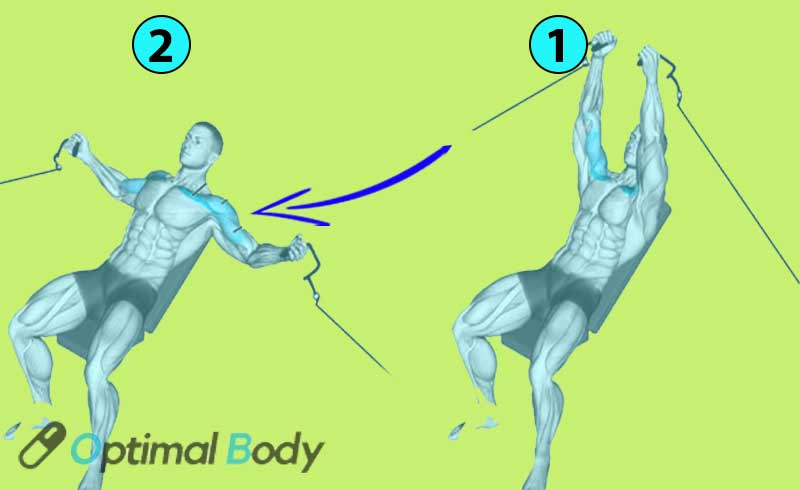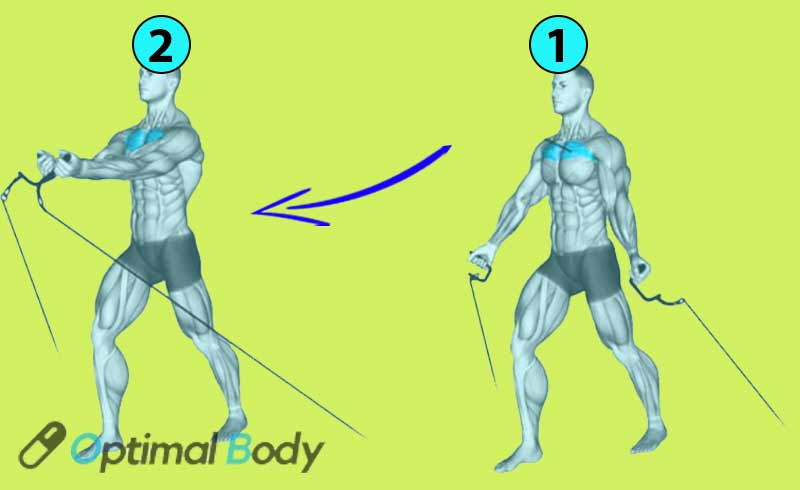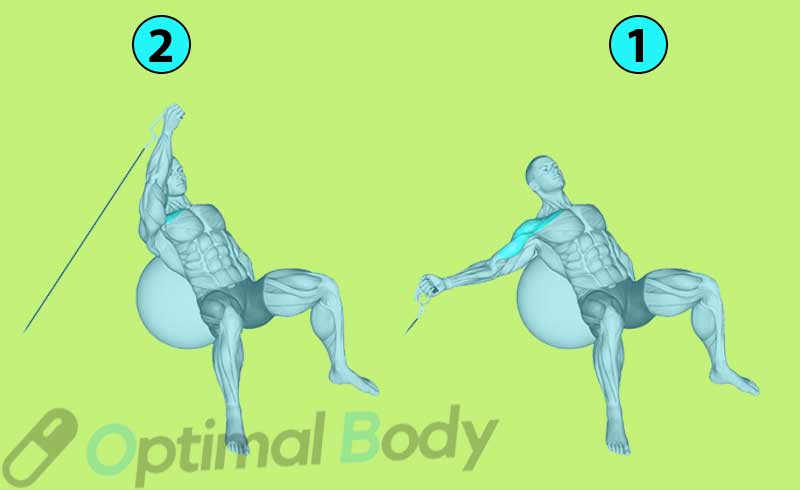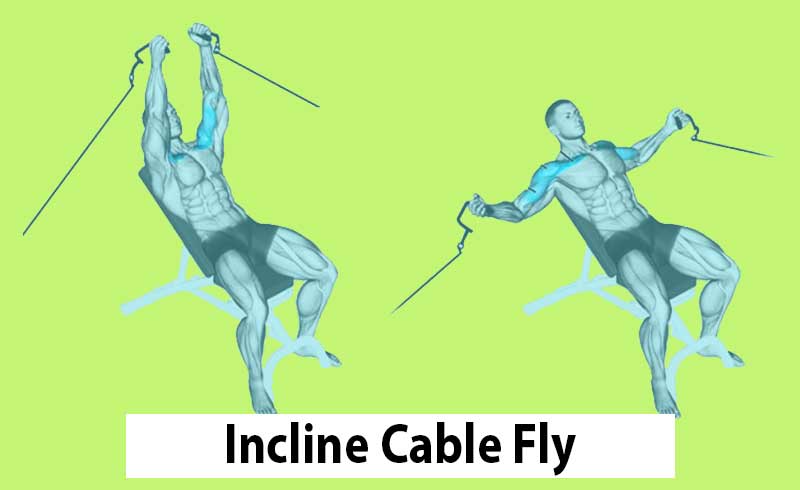Elevate your upper chest training with the incline cable fly exercise.
The Cable Incline Pec Fly is a standout among exercises that effectively target the clavicular head of the pectoralis major.
This exercise aids in fortifying the chest and shoulders by engaging the upper chest from various angles.
Within this article, we will delve into the following aspects:
- Definition and Execution of the Incline Cable Chest Fly
- Advantages of Incorporating the Exercise
- Muscles Engaged During the Incline Fly
- Detailed Instructions and Pro Tips
- Common Mistakes to Avoid
So, gather your cables and prepare to stimulate your pectoral muscles in a whole new way.
What Is the Incline Cable Fly?
The incline cable fly is an isolation exercise primarily aimed at engaging the upper chest muscles.
It entails using a cable machine with adjustable pulleys in conjunction with a bench inclined at approximately 30–45 degrees.
Unlike dumbbells, the cable mechanism maintains constant tension throughout the movement, leading to enhanced development of upper chest fibers.
Moreover, the exercise’s versatility allows for variation by employing diverse cable attachments, thereby adding diversity to your chest workout.
Benefits of the Cable Incline Fly
1. Muscle Isolation:
The cable fly specifically isolates the upper chest muscles, fostering improved muscle activation and hypertrophy.
2. Joint-Friendly Movement:
Individuals who experience joint discomfort during the incline bench press can turn to the incline cable chest fly as a preferable alternative.
The cable alteration in movement angle mitigates potential joint stress when coupled with proper shoulder-blade stability.
3. Full Range of Motion:
Unlike other exercises, the incline cable chest fly maintains consistent load distribution on the chest muscles across the entire range of motion.
4. Chest Opening Effect:
The exercise serves as a beneficial chest opener that promotes scapular retraction. This action, crucial for countering poor posture, involves pinching the shoulder blades together.
5. Constant Muscle Stimulation:
The cable setup sustains nearly uninterrupted tension on the muscles, contributing to substantial muscle pump and optimal muscle growth.
6. Versatility in Training:
The incline cable flye can be performed with a variety of angles and attachments, introducing diversity to your chest workout and preventing monotony.
Muscles Targeted by the Incline Cable Fly
The primary muscles targeted by the incline cable fly are the upper pectoralis major muscles.
Additionally, synergist muscles like the rhomboids, levator scapulae, anterior deltoids, and latissimus dorsi are involved.
Stabilizer muscles such as the biceps brachii, brachialis, wrist flexors, obliques, and rectus abdominis also play a role during the exercise.
How To Do The Incline Cable Fly: Step by Step

- Adjust the bench to a 30-45 degree incline angle, ensuring its stability.
- Fix stirrup handles to the low pulleys and lie on the bench with feet firmly planted.
- Hold the cable handles with an overhand grip, arms extended forward, palms facing each other.
- Gradually extend your arms outward to your sides, maintaining slightly bent elbows and parallel upper arms.
- Draw your arms back together towards your midline, focusing on utilizing the pec muscles.
- Perform the desired number of repetitions, upholding proper form throughout.
Incline Cable Chest Fly Training Volume
Incorporate incline cable chest fly into your routine using these guidelines:
Sets:
Beginners: Around 3-4 sets weekly.
Intermediate: About 5-8 sets weekly.
Advanced: Approximately 8-10 sets weekly.
Reps:
6–8 reps for strength.
8–15 reps for muscle hypertrophy.
15-20+ reps for endurance.
Frequency: Perform 1–2 times per week based on your workout plan and goals.
Noteworthy Alternatives to the Incline Cable Fly
Pro Tips:
- Maintain core engagement and a flat back against the bench.
- Choose a challenging weight that still permits the correct form.
- Exhale as you bring the handles together, and inhale during the descent.
- Modify the bench angle for varied upper chest angles.
- Emphasize chest muscle contraction during handle convergence.
- Opt for an incline angle of about 30–45 degrees to target the chest optimally.
- Ensure your elbows remain in line with your torso during the start position.
- Select a weight that offers control without being excessively light or heavy.
Effective Variations of Incline Cable Flyes
Doing incline cable chest fly variations carries several advantages:
- Diversify your workout routine.
- Breaks through plateaus in progress.
- Combats monotony, fostering greater muscle development and definition.
1. Standing Incline Cable Fly
Also known as the low-to-high cable fly, this exercise bolsters the pushing muscles – chest, shoulders, and triceps.
It emphasizes constant tension, contributing to the development and definition of the upper and inner chest.
Execution:

- Set the pulleys low, grasp the overhead handles.
- Slightly lean forward, extend your arms and feel the chest stretch.
- Bend your elbows slightly, pull hands together in wide arcs.
- Lower back to start position, repeat as desired.
2. Single Arm Incline Cable Fly
This variation is beneficial for correcting imbalances between the two chest sides and increasing core engagement for stability.
Execution:

- Set up the cable pulley low and position your bench nearby.
- Grasp one handle, bring it to your sternum, and lie flat on the bench.
- Keep your palm facing up and extend your arm above your chest.
- Slowly return the handle to the starting position.
- Repeat for the desired number of reps, focusing on one side at a time.
Incline Cable Flie Alternatives:
For those seeking alternatives that target the same muscle groups, consider:
- Incline Dumbbell Fly
- Decline Push-Ups
- Incline Dumbbell Press
- Landmine Chest Press
- Incline Bench Dumbbell Pullover
Frequently Asked Questions (FAQs)
1. What’s the Optimal Incline Angle for the Cable Fly?
The recommended range for incline cable fly is 30–45 degrees. This angle optimally targets upper chest muscles while minimizing strain on shoulder joints.
2. Is the Incline Cable Fly Suitable for Beginners?
Yes, beginners can safely engage in this exercise with proper form and an appropriate weight for controlled movement.
3. How does the Incline Cable Fly Differ from the Incline Bench Press?
While both exercises target upper chest muscles, the incline cable fly involves pulling the cables toward your chest in a fly-like motion. This creates a distinct range of motion and continuous tension compared to the incline bench press.
4. Are Incline Flys Worth the Effort?
Yes, incline flye are valuable for targeted chest development. However, their efficacy hinges on correct execution, suitable weight selection, and integration within a balanced workout routine.
Takeaways
Incorporating incline cable flys enhances chest muscle engagement.
Integrate this exercise with other chest-focused movements like bench presses, push-ups, or chest flys for a comprehensive chest workout routine.
- Bench Press Calculator - April 22, 2024
- Press to Handstand: Ultimate Step-by-Step Guide - April 22, 2024
- Cable Press (How To Do, Benefits, Targeted Muscles, Alternative) - April 22, 2024

